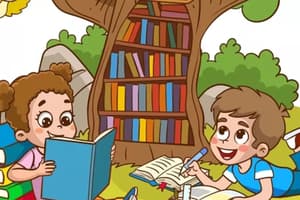Podcast
Questions and Answers
What is a crucial factor in engaging students with ELA instruction?
What is a crucial factor in engaging students with ELA instruction?
- Ignoring cultural backgrounds
- Focusing only on reading skills
- Standardized testing approaches
- Addressing diverse cultural backgrounds (correct)
Which approach helps improve students' comprehension in reading?
Which approach helps improve students' comprehension in reading?
- Memorization of texts
- Reading strategies (correct)
- Passive reading techniques
- Summarizing after reading
What key element is important in the writing process?
What key element is important in the writing process?
- Finalizing drafts without revisions
- Focusing solely on grammar
- Brainstorming and revising (correct)
- Ignoring feedback from peers
Which skill is essential for effective communication in writing?
Which skill is essential for effective communication in writing?
What does literary analysis aim to achieve?
What does literary analysis aim to achieve?
How does media literacy benefit students?
How does media literacy benefit students?
What is the purpose of formative assessments in ELA?
What is the purpose of formative assessments in ELA?
Which outcome does effective vocabulary development seek to achieve?
Which outcome does effective vocabulary development seek to achieve?
Which of the following skills is NOT typically emphasized in English Language Arts instruction?
Which of the following skills is NOT typically emphasized in English Language Arts instruction?
What is a primary goal of ELA instruction?
What is a primary goal of ELA instruction?
Which of the following aspects is crucial for understanding literary works in ELA?
Which of the following aspects is crucial for understanding literary works in ELA?
What role does critical thinking play in ELA instruction?
What role does critical thinking play in ELA instruction?
Which of the following best describes process writing in ELA?
Which of the following best describes process writing in ELA?
Which method of assessment is commonly used in ELA?
Which method of assessment is commonly used in ELA?
Which of the following literary devices is important in understanding literature?
Which of the following literary devices is important in understanding literature?
What is a key benefit of incorporating diverse perspectives in ELA instruction?
What is a key benefit of incorporating diverse perspectives in ELA instruction?
Flashcards
ELA Skills
ELA Skills
Reading, writing, listening, and speaking skills developed in English Language Arts.
Reading Comprehension
Reading Comprehension
Understanding and interpreting written texts.
Writing Development
Writing Development
Creating written work like essays, narratives.
Literary Genres
Literary Genres
Signup and view all the flashcards
Literary Devices
Literary Devices
Signup and view all the flashcards
Critical Thinking
Critical Thinking
Signup and view all the flashcards
Process Writing
Process Writing
Signup and view all the flashcards
Vocabulary Development
Vocabulary Development
Signup and view all the flashcards
Reading Strategies
Reading Strategies
Signup and view all the flashcards
Writing Processes
Writing Processes
Signup and view all the flashcards
Grammar and Mechanics
Grammar and Mechanics
Signup and view all the flashcards
Literary Analysis
Literary Analysis
Signup and view all the flashcards
Language and Culture
Language and Culture
Signup and view all the flashcards
Media Literacy
Media Literacy
Signup and view all the flashcards
Study Notes
English Language Arts (ELA)
- ELA encompasses a broad range of language and literacy skills, including reading, writing, listening, and speaking.
- It aims to develop students' abilities to understand and use language effectively in various contexts.
- ELA instruction often focuses on developing critical thinking skills, including analysis, interpretation, and evaluation.
- Key aspects of ELA often involve:
- Reading comprehension: understanding and interpreting written texts.
- Writing development: composing different types of written work, such as essays, narratives, and poems.
- Language conventions: mastering grammar, punctuation, and usage.
- Vocabulary development: expanding knowledge of words and their meanings.
- Listening comprehension: understanding spoken language.
- Oral communication: expressing ideas effectively through speaking.
- ELA instruction fosters essential skills such as critical thinking, creativity, and communication, all beneficial for pursuing and achieving various academic and professional goals.
- Developing effective reading strategies, whether for informational or literary texts, is crucial in ELA.
- Recognizing different literary genres (e.g., fiction, non-fiction, poetry) and the elements that define them is a part of ELA.
- Writing instruction often involves various genres and focuses on process writing, encouraging multiple drafts and feedback in the writing process, making it an iterative and developmental activity.
- Understanding literary devices (e.g., metaphor, symbolism, imagery) is integral to appreciating the nuances of the written word.
- Analyzing the themes and messages embedded within a text helps in appreciating literature better.
- ELA instruction often utilizes various forms of media, including technology, facilitating learning and understanding in engaging ways.
- The specific curriculum and standards for ELA vary by grade level, educational institution, and geographical location, often adhering to national or state standards established for achieving literacy levels.
- Assessment methods in ELA can be varied, depending on the goals to attain. This could include written assignments, presentations, quizzes, and projects encompassing different aspects of the learning objectives.
- Incorporating and responding to diverse perspectives within texts and fostering respect for different voices and experiences are critical goals in contemporary ELA.
- Language acquisition and its diverse facets are prominent considerations and learning outcomes.
- Students' cultural backgrounds play a significant role in their engagement with ELA instruction, and addressing these diverse experiences is crucial.
- Emphasis on developing a love for reading and learning through diverse texts is essential.
- Utilizing meaningful texts pertinent to the student life experiences to foster a love of reading is paramount.
- ELA skills are essential for active participation in society.
Key Concepts in ELA Instruction
- Reading Strategies: Employing reading strategies to improve comprehension. These are active techniques guiding readers' engagement, which fosters an appreciation for literature and enables students to better understand texts.
- Writing Processes: The developmental writing process focuses on stages from brainstorming to revision, encouraging critical self-assessment and feedback from others to improve the writing quality.
- Vocabulary Development: This is an ongoing process that focuses on understanding word structures or context to improve expression and overall language comprehension.
- Grammar and Mechanics: Knowledge of proper grammar and usage of language conventions to effectively communicate ideas in well-structured writing.
- Literary Analysis: The detailed study of literary works, breaking them down to identify and interpret literary devices, patterns, and themes.
- Critical Thinking: Cultivating critical thinking to allow students to evaluate evidence, form opinions, and formulate thoughtful responses to multiple perspectives.
- Language and Culture: Appreciation for diverse linguistic and cultural backgrounds, helping students understand and embrace different viewpoints within texts.
- Media Literacy: Developing the ability to critically analyze messages and information conveyed through different media, including technology.
Assessment in ELA
- Assessments in ELA are diverse and should go beyond testing isolated skills.
- These should ideally look at broader capabilities of language, reading, and written expression, fostering a lifelong appreciation for the subjects' value.
- Assessment should help track learning progress and provide feedback to guide future instruction and development.
- Formative assessments provide ongoing insights and adjust teaching methods more effectively and promptly.
- Summative assessments offer a more comprehensive analysis of learning outcomes and understanding at given intervals.
- Authentic assessments incorporate real-world tasks to measure students' capability to apply acquired skills in diverse contexts, moving beyond conventional formats.
- Effective assessment methods are often combined, allowing for a holistic and accurate evaluation of progress and understanding in ELA.
Studying That Suits You
Use AI to generate personalized quizzes and flashcards to suit your learning preferences.




